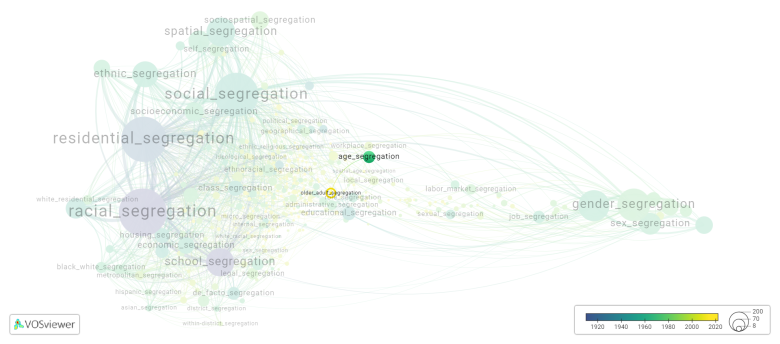Older adult segregation: Difference between revisions
(Creating page) |
(Creating page) |
||
| (3 intermediate revisions by the same user not shown) | |||
| Line 16: | Line 16: | ||
Efforts to reduce older adult segregation include promoting inclusivity and accessibility in communities, fostering intergenerational programs and activities, and challenging ageist attitudes and stereotypes. Creating age-friendly environments that support older adults' social engagement and inclusion is key to combating older adult segregation. | Efforts to reduce older adult segregation include promoting inclusivity and accessibility in communities, fostering intergenerational programs and activities, and challenging ageist attitudes and stereotypes. Creating age-friendly environments that support older adults' social engagement and inclusion is key to combating older adult segregation. | ||
==See also== | ==See also== | ||
==Related segregation forms== | |||
Older adult segregation is frequently discussed in the literature with the following segregation forms: | |||
[[age segregation]], [[intergenerational segregation]] | |||
[[File:older_adult_segregation.png|780x780px]] | |||
This visualization is based on the study [[Segregation_Wiki:About| The Multidisciplinary Landscape of Segregation Research]]. | |||
For the complete network of interrelated segregation forms, please refer to: | |||
* [https://tinyurl.com/2235lkhw First year of publication] | |||
* [https://tinyurl.com/2d8wg5n3 Louvain clusters] | |||
* [https://tinyurl.com/223udk5r Betweenness centrality] | |||
* [https://tinyurl.com/244d8unz Disciplines in which segregation forms first emerged (Scopus database).] | |||
==References== | ==References== | ||
==Notes== | ==Notes== | ||
Latest revision as of 07:17, 16 October 2024
Date and country of first publication[1][edit | edit source]
2022
United States
Definition[edit | edit source]
Older adult segregation refers to the separation or isolation of older adults from the broader society or from other age groups within society. This can occur in various settings such as residential facilities, nursing homes, or even within communities.
There are several factors that contribute to older adult segregation. One prominent reason is the physical and mental health issues associated with aging, which may require specialized care and support. This can lead to the creation of specific facilities or institutions that cater exclusively to older adults.
Another factor is societal attitudes and stereotypes about aging. Negative perceptions about older adults, such as assumptions of frailty or incompetence, can result in social exclusion and segregation. Ageism, a form of discrimination against older individuals, can contribute to the marginalization and isolation of older adults from the wider community.
Furthermore, socioeconomic factors may play a role in older adult segregation. Limited financial resources or lack of access to transportation can impede older adults' ability to engage in social activities and interact with people of different age groups.
The consequences of older adult segregation can be detrimental. It can lead to increased social isolation, which has been linked to negative health outcomes such as depression, cognitive decline, and reduced quality of life. Older adults who are segregated may also miss out on opportunities for intergenerational connections and the benefits that come from diverse social interactions.
Efforts to reduce older adult segregation include promoting inclusivity and accessibility in communities, fostering intergenerational programs and activities, and challenging ageist attitudes and stereotypes. Creating age-friendly environments that support older adults' social engagement and inclusion is key to combating older adult segregation.
See also[edit | edit source]
Related segregation forms[edit | edit source]
Older adult segregation is frequently discussed in the literature with the following segregation forms:
age segregation, intergenerational segregation

This visualization is based on the study The Multidisciplinary Landscape of Segregation Research.
For the complete network of interrelated segregation forms, please refer to:
References[edit | edit source]
Notes[edit | edit source]
- ↑ Date and country of first publication as informed by the Scopus database (December 2023).
At its current state, this definition has been generated by a Large Language Model (LLM) so far without review by an independent researcher or a member of the curating team of segregation experts that keep the Segregation Wiki online. While we strive for accuracy, we cannot guarantee its reliability, completeness and timeliness. Please use this content with caution and verify information as needed. Also, feel free to improve on the definition as you see fit, including the use of references and other informational resources. We value your input in enhancing the quality and accuracy of the definitions of segregation forms collectively offered in the Segregation Wiki ©.
Older adult segregation appears in the following literature[edit | edit source]
Das Gupta D., Wong D.W.S. (2022). Changing Age Segregation in the US: 1990 to 2010. Research on Aging, 44(9-10), 669-681. SAGE Publications Inc..https://doi.org/10.1177/01640275221074398
